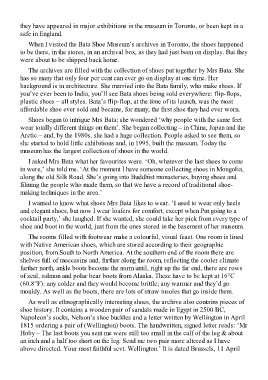Page 352 - The Secret Museum
P. 352
they have appeared in major exhibitions in the museum in Toronto, or been kept in a
safe in England.
When I visited the Bata Shoe Museum’s archives in Toronto, the shoes happened
to be there, in the stores, in an archival box, as they had just been on display. But they
were about to be shipped back home.
The archives are filled with the collection of shoes put together by Mrs Bata. She
has so many that only four per cent can ever go on display at one time. Her
background is in architecture. She married into the Bata family, who make shoes. If
you’ve ever been to India, you’ll see Bata shoes being sold everywhere: flip-flops,
plastic shoes – all styles. Bata’s flip-flop, at the time of its launch, was the most
affordable shoe ever sold and became, for many, the first shoe they had ever worn.
Shoes began to intrigue Mrs Bata; she wondered ‘why people with the same feet
wear totally different things on them’. She began collecting – in China, Japan and the
Arctic – and, by the 1980s, she had a huge collection. People asked to see them, so
she started to hold little exhibitions and, in 1995, built the museum. Today the
museum has the largest collection of shoes in the world.
I asked Mrs Bata what her favourites were. ‘Oh, whatever the last shoes to come
in were,’ she told me. ‘At the moment I have someone collecting shoes in Mongolia,
along the old Silk Road. She’s going into Buddhist monasteries, buying shoes and
filming the people who made them, so that we have a record of traditional shoe-
making techniques in the area.’
I wanted to know what shoes Mrs Bata likes to wear. ‘I used to wear only heels
and elegant shoes, but now I wear loafers for comfort, except when Pm going to a
cocktail party,’ she laughed. If she wanted, she could take her pick from every type of
shoe and boot in the world, just from the ones stored in the basement of her museum.
The rooms filled with footwear make a colourful, visual feast. One room is lined
with Native American shoes, which are stored according to their geographic
position, from South to North America. At the southern end of the room there are
shelves full of moccasins and, further along the room, reflecting the cooler climate
further north, ankle boots become the norm until, right up the far end, there are rows
of seal, salmon and polar bear boots from Alaska. These have to be kept at 16°C
(60.8°F): any colder and they would become brittle; any warmer and they’d go
mouldy. As well as the boots, there are lots of straw insoles that go inside them.
As well as ethnographically interesting shoes, the archive also contains pieces of
shoe history. It contains a wooden pair of sandals made in Egypt in 2500 BC,
Napoleon’s socks, Nelson’s shoe buckles and a letter written by Wellington in April
1815 ordering a pair of (Wellington) boots. The handwritten, signed letter reads: ‘Mr
Hoby – The last boots you sent me were still too small in the calf of the leg & about
an inch and a half too short on the leg. Send me two pair more altered as I have
above directed. Your most faithful sevt. Wellington.’ It is dated Brussels, 11 April

